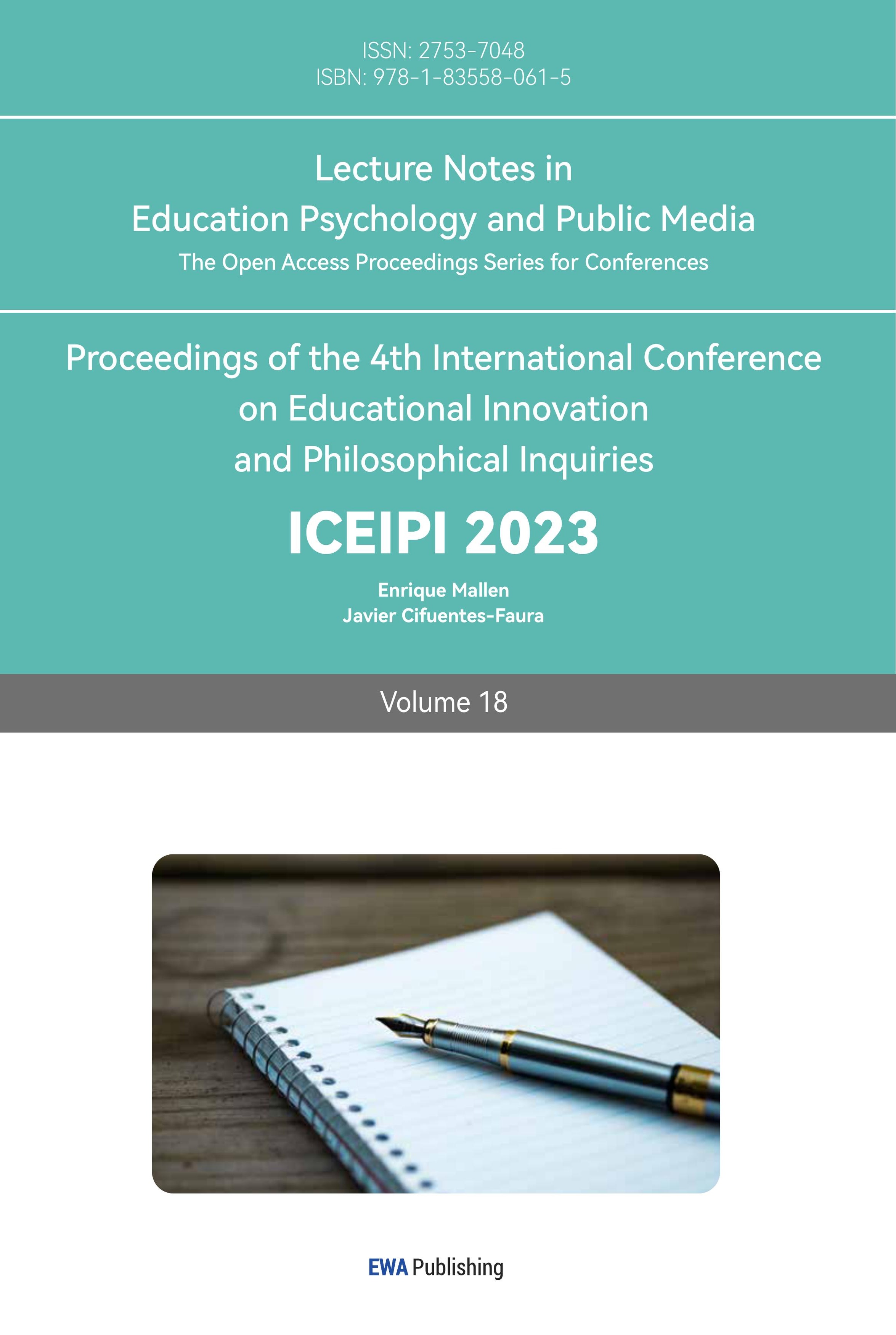References
[1]. Fergus, J. (1983). Pride and Prejudice. In: Jane Austen and the Didactic Novel. Palgrave Macmillan, London.
[2]. Ashton-James C E, Tracy J L. (2012). Pride and prejudice: how feelings about the self influence judgments about others. Pers Soc Psychol Bull, 38(4):466-476.
[3]. Zhu Xiaozhou. (2002). A Speech-Act Perspective on Irony in Pride and Prejudice. Foreign Languages and Their Teaching.
[4]. Padilla, A.M. (2008). Social Cognition, Ethnic Identity, and Ethnic Specific Strategies for Coping with Threat due to Prejudice and Discrimination. In: Willis-Esqueda, C. (eds) Motivational Aspects of Prejudice and Racism. THE NEBRASKA SYMPOSIUM ON MOTIVATION. Springer, New York, NY.
[5]. Microsoft.https://learn.microsoft.com/en-us/previous-versions/technet-magazine/dd822910(v=msdn.10)?redirectedfrom=MSDN.
[6]. Johannesen, L. Richard. (1987). “Richard M. Weaver's uses of Kenneth Burke.” Southern Speech Communication Journal. 12.3:312-330.
[7]. Oatley, K. (2016). Imagination, Inference, Intimacy: The Psychology of Pride and Prejudice. Review of General Psychology, 20(3), 236–244.
[8]. Huishan Chen. (2007) “An Analysis of Women’s Social Status at Bourgeois Times from Marriage in Pride and Prejudice.” English Corner 6:3.
[9]. ZHANG Li. (2009). “Inferiority and Compensation — A Psychological Interpretation on the Characters in Pride and Prejudice.” Journal of Guangxi Teachers Education University(Philosophy and Social Sciences Edition).
[10]. Mubarak, N., Ferguson, C. J. (2022). Pride and prejudice and zombies…and statistics: Effects of powerful female role-models in media on attitudes towards women, and female viewer anxiety. Curr Psychol 41, 691–696.
[11]. Strout, S. L., et al. (2010). “Pride and prejudice or children and cheating? Jane Austen’s representations of female mating strategies.” Journal of Social 4.4:317-331.
[12]. WANG Yu. (2005). “A General Discussion on Jane Austin’s Marital Viewpoints from Pride and Prejudice.” Journal of Shaanxi Institute of Education.
Cite this article
Zhang,W. (2023). An Analysis of the Movie “Pride and Prejudice” — from the Perspective of Social Psychology and Sociology. Lecture Notes in Education Psychology and Public Media,18,22-26.
Data availability
The datasets used and/or analyzed during the current study will be available from the authors upon reasonable request.
Disclaimer/Publisher's Note
The statements, opinions and data contained in all publications are solely those of the individual author(s) and contributor(s) and not of EWA Publishing and/or the editor(s). EWA Publishing and/or the editor(s) disclaim responsibility for any injury to people or property resulting from any ideas, methods, instructions or products referred to in the content.
About volume
Volume title: Proceedings of the 4th International Conference on Educational Innovation and Philosophical Inquiries
© 2024 by the author(s). Licensee EWA Publishing, Oxford, UK. This article is an open access article distributed under the terms and
conditions of the Creative Commons Attribution (CC BY) license. Authors who
publish this series agree to the following terms:
1. Authors retain copyright and grant the series right of first publication with the work simultaneously licensed under a Creative Commons
Attribution License that allows others to share the work with an acknowledgment of the work's authorship and initial publication in this
series.
2. Authors are able to enter into separate, additional contractual arrangements for the non-exclusive distribution of the series's published
version of the work (e.g., post it to an institutional repository or publish it in a book), with an acknowledgment of its initial
publication in this series.
3. Authors are permitted and encouraged to post their work online (e.g., in institutional repositories or on their website) prior to and
during the submission process, as it can lead to productive exchanges, as well as earlier and greater citation of published work (See
Open access policy for details).
References
[1]. Fergus, J. (1983). Pride and Prejudice. In: Jane Austen and the Didactic Novel. Palgrave Macmillan, London.
[2]. Ashton-James C E, Tracy J L. (2012). Pride and prejudice: how feelings about the self influence judgments about others. Pers Soc Psychol Bull, 38(4):466-476.
[3]. Zhu Xiaozhou. (2002). A Speech-Act Perspective on Irony in Pride and Prejudice. Foreign Languages and Their Teaching.
[4]. Padilla, A.M. (2008). Social Cognition, Ethnic Identity, and Ethnic Specific Strategies for Coping with Threat due to Prejudice and Discrimination. In: Willis-Esqueda, C. (eds) Motivational Aspects of Prejudice and Racism. THE NEBRASKA SYMPOSIUM ON MOTIVATION. Springer, New York, NY.
[5]. Microsoft.https://learn.microsoft.com/en-us/previous-versions/technet-magazine/dd822910(v=msdn.10)?redirectedfrom=MSDN.
[6]. Johannesen, L. Richard. (1987). “Richard M. Weaver's uses of Kenneth Burke.” Southern Speech Communication Journal. 12.3:312-330.
[7]. Oatley, K. (2016). Imagination, Inference, Intimacy: The Psychology of Pride and Prejudice. Review of General Psychology, 20(3), 236–244.
[8]. Huishan Chen. (2007) “An Analysis of Women’s Social Status at Bourgeois Times from Marriage in Pride and Prejudice.” English Corner 6:3.
[9]. ZHANG Li. (2009). “Inferiority and Compensation — A Psychological Interpretation on the Characters in Pride and Prejudice.” Journal of Guangxi Teachers Education University(Philosophy and Social Sciences Edition).
[10]. Mubarak, N., Ferguson, C. J. (2022). Pride and prejudice and zombies…and statistics: Effects of powerful female role-models in media on attitudes towards women, and female viewer anxiety. Curr Psychol 41, 691–696.
[11]. Strout, S. L., et al. (2010). “Pride and prejudice or children and cheating? Jane Austen’s representations of female mating strategies.” Journal of Social 4.4:317-331.
[12]. WANG Yu. (2005). “A General Discussion on Jane Austin’s Marital Viewpoints from Pride and Prejudice.” Journal of Shaanxi Institute of Education.









